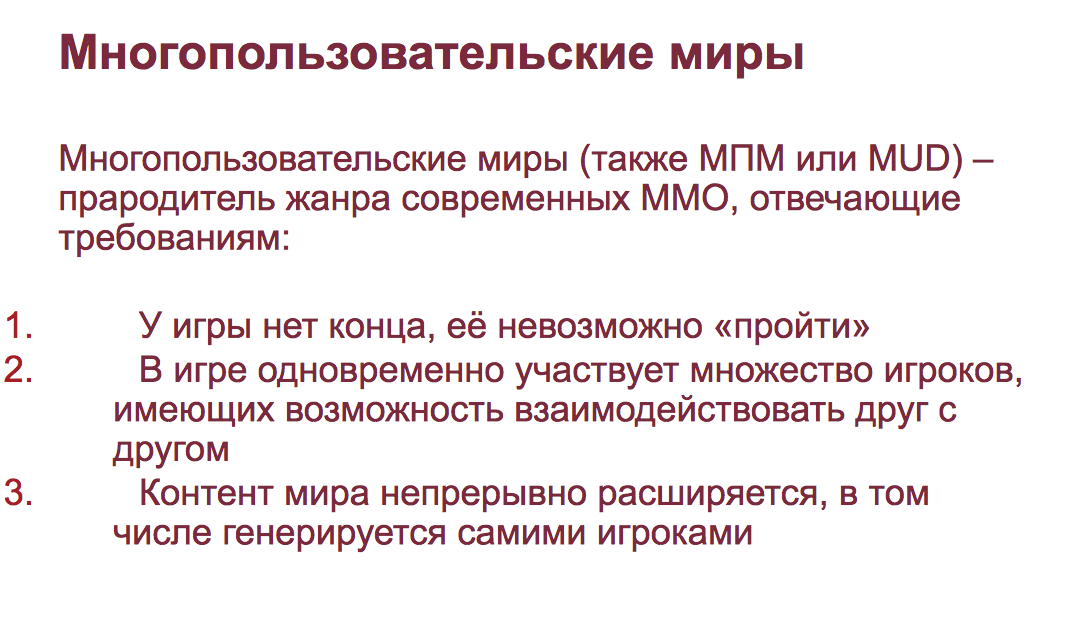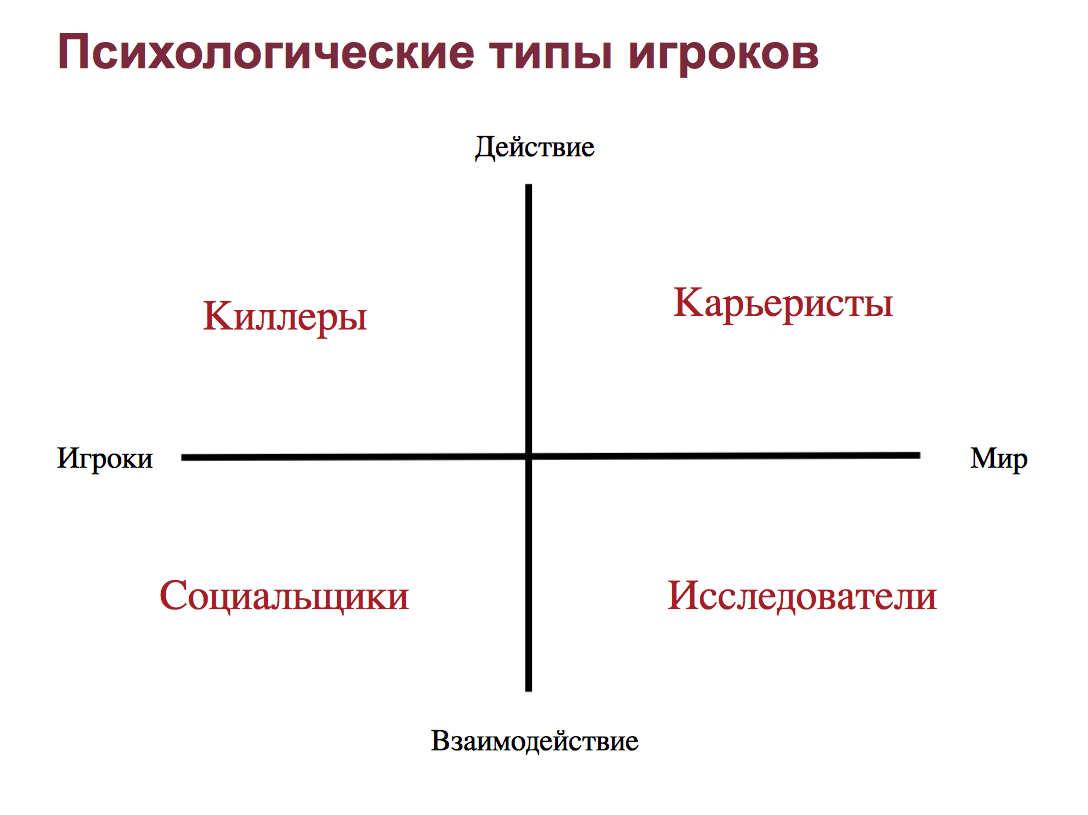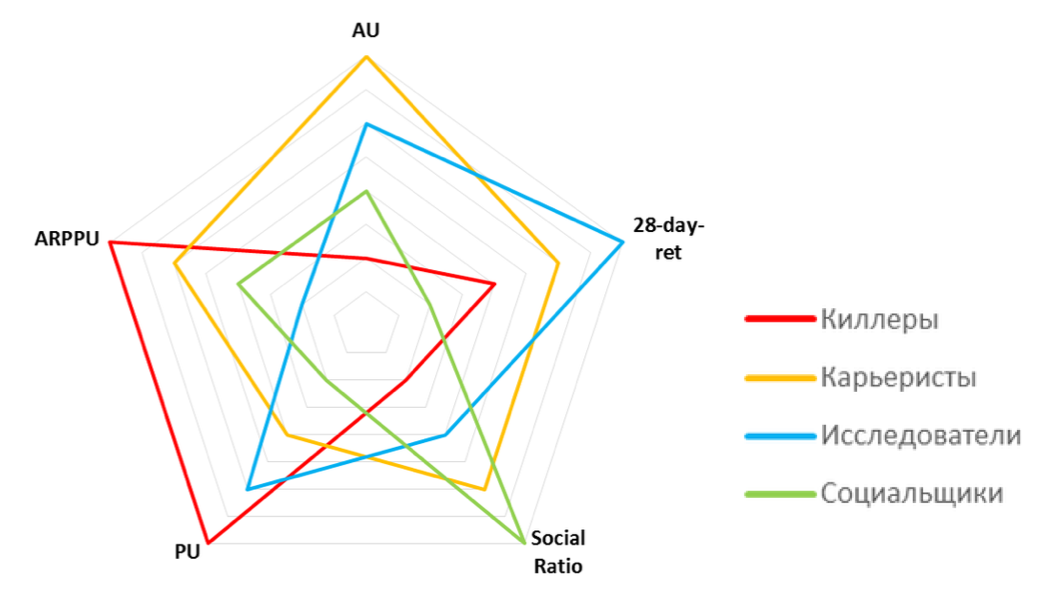Psychotypes of players: what are players willing to pay for?
What types of players are there, how they behave in MMO games and with what functionality they are monetized, – he told the students The Higher School of Business Informatics is the leading analyst of 101XP Alexey Filatov. Especially for App2Top.ru the school has prepared a lecture summary. We share.
The report was read at the Higher School of Business Informatics in February as part of a one-day lecture session on the gaming industry, open to everyone. The teachers of the Game Project Management program and invited experts shared their experience with the guests.
This lecture is based on Richard Bartle’s theory of player psychotypes and reveals both the psychology of player behavior in games and the features of monetization of different player psychotypes.
A little historical background: Richard Alan Bartle (Richard Allan Bartle) was born in 1960 in England. He is a sociologist by education. When Bartle was at university, he became interested in computer games. Most of what he did is collected in the book Designing Virtual Worlds.

In 1978, at the age of 18, Bartle, along with his friend Roy Trubshaw, created the first multiplayer world.

It was Trubshaw who coined the term MUD (Multi User Dungeon). MUD still exists today. You can play it.

Richard Bartle acted as a game designer in this project. But gradually he began to notice that despite the fact that all players behave differently in the game, they are grouped by psychotypes. They have the same patterns of behavior. Based on this, he began to collect statistical information, conduct a survey inside the game and try to figure out what these people are doing here.
Bartle laid out all the interests of users on a scale. He got a matrix in which all the actions of the players fit. On the X axis – players and the world, and on the Y axis – action and interaction.

And at the intersection of these scales, 4 classic psychotypes of players turned out: killers, careerists, sociologists and researchers.

When Bartle formulated 4 psychotypes, he did not stop there. First he divided each one into 2 more, then 2 more: now there are 24 psychotypes of players in his research. But game designers still use division by 4 because it is convenient, simple and easy to remember.
The first psychotype is Killers
The killers want to influence the players. They value strength, skill, influence and dominance. They like to kill other people. And through this they get pleasure. That’s why they come to the games. One of the most common genres dominated by killer shooters.

The second psychotype is Careerists
From the point of view of statistics, careerists are the most common psychotype. They want to influence the world. They value power, resources, opportunities, status. They want to become masters of the situation, to be rich and influential. What do these people play most often? Of course, in RPG, because it’s the perfect genre for them, where they can get what they want.

The third psychotype – Researchers
These are people for whom interaction with the world is important. They don’t want to bend the world like careerists, they want to explore it, understand it. Researchers value knowledge, skills, an abundance of content, want to reveal secrets, have the most information about the game. They appreciate what others don’t know. Most often, researchers play quests. At the same time, if there are quests in the RPG, then there are researchers there.

The fourth psychotype is sociologists
For social workers, the game is not very important, for them the people in this game are more important. They want to communicate, interact with other players. Social connections are important for them.
Social workers appreciate popularity, communication, interpersonal communication, these are the people who talk the most in the chat. Most often – not on the topic of the game. Social workers really appreciate any game where there is a chat. But there is a place where there are by definition the most social workers. These are, of course, games on social networks. In addition, mobile games, which are an element of social culture, also attract a lot of social workers.

The relationship between psychotypes
Each game has different ratios of psychotypes, it even happens that some of them are not in a particular game. In a good game, according to Richard Bartle, each of the psychotypes of the players has something to do. Based on this, Bartle decided that the game they made with a friend was good, since all four psychotypes had something to do there.
If there are no features for any psychotype in the game, then people who are prone to certain behavior begin to behave differently. They are looking for substitutes. For example, if there is no killing of players in the game, then the killers start “killing” people in the chat with words.

The picture shows one of the examples of the ratio. The ratio varies, depending on the game. For example, there are more researchers in quests, and there are more killers in shooters.
Bartle not only studied the people in his game, he also compiled a test to determine the type of player. At the end of the article, you will find a link to its passage. He concluded that all these psychotypes are reflected in real life. That is, people who like to “kill” other people in the game like to do it in real life. Of course, not in the literal sense of the word. People who behave like careerists in one game will behave like that in another game.
Impact on game performance
Psychotypes have a very strong influence on game performance. The picture below shows how users behave in games depending on their psychotype.

28-day-ret – retention for 28 days, PU – percentage of paying users, ARPPU – average revenue per paying user for the billing period (month), AU – percentage of active players, Social Ratio – the level of social interaction in the game.
Pay attention to the killers (red). They have one of the highest ARPPU: they pay, and a lot.
In monetization, it is customary to divide all paying players into whales, dolphins and minnows. Whales are most often killers, people who seek to dominate. In addition to the fact that they have the largest ARPPU indicator, they are also the most among the paying audience. At the same time, from the point of view of social interaction, there are fewer killers. They don’t want to communicate with other people. What should I talk to them about? Kill, kill, and kill again. At the same time, they have an average retention of 28 days: if, when they come into the game, they do not get what they want, the killers leave pretty quickly.
Careerists (yellow) are the core of the active audience. They pay on average, the percentage of those paying among them is less than among the killers. Social interaction and retention for 28 days is also average. Careerists are the basis of the game. If there is nothing for a careerist to do in your game, you will never have a high retention and an active audience.
Researchers (blue) play for a long time because they need to discover all the secrets of the world. They hardly pay. Those who are engaged in monetization have a joke that if a researcher paid, it was only in order to understand how the payment acceptance system works. Researchers play for a long time, but at the same time they spend very little time playing a game a day. I hardly interact with each other in games.
Social workers (yellow) do not like to pay at all. For obvious reasons, their social interaction is very high. Retention of 28 days is average, but they are also delayed for a long time, as are the researchers. The percentage of paying among them is very low.
How does all this work in practice?
Features for killers
What killer features do you need to have in the game? The first thing that comes to mind is, of course, PvP battles. Ratings, marathons, competitions and the presence of podlanok, curses are also important.
A show of force – killers should look intimidating, so that everyone understands that they can kill. These are the two-meter swords from the Korean games. The killers have very high requirements for skills so that they are very powerful.

What are the killers willing to pay for?
First of all, they pay to skip the pumping. They hate grind, they think it’s an extra part of the game. If the killer is offered to immediately buy a high-level character, then the killer will buy it. The only question is whether he will buy it from you developers or from other players. Therefore, one of the most popular features for killers is the acceleration of pumping. For example, using a VIP or Premium account.
Who most often buys vipka in World of Tanks? Killers! They want to pump faster. They are also willing to pay a lot for powerful weapons and visual confirmation of strength, that is, images that look dominant.

Features for careerists
Careerists are very fond of grinding. They think that the grind is the main part of the game, and everyone who misses it is idiots. Careerists are the very people who go to the wild boars, knocking off one experience point each to raise their level. But at the same time they are willing to pay for an increase in production.
Careerists are very fond of collecting everything related to crafting and the accumulation of resources and values. The creature in the picture just below is a typical careerist.

Careerists also love daily bonuses, they are ready to enter the game every day just for them.
What are careerists willing to pay for?
For VIP and Premium, but only if it gives more money and more resources. In this context, the Wargaming vipka with World of Tanks gives not only an increase in experience, but also more loot per battle.
Unlike killers who pay for an attack, careerists are willing to pay for protection. They don’t really like attacking other people themselves, but they are willing to pay to be protected themselves.
Careerists are very fond of mobs and pets. For them, this is an indicator of status: the more animals around them, the more solid they look.
Also, careerists are the very people who buy chests and are ready to participate in contests “Who bought more chests”.

Features for researchers
The most important thing for researchers is talents, development, a non–linear plot, everything related to hardcore quests, like Fallout. They love it when the time of day depends on whether they will give a quest or not. That is why the first and second parts of Fallout are so popular with researchers.
They also like huge locations, a large amount of content, quests, dialogues, random events and a variety of choices and balance. In RPG, researchers like to pump one class first, then the second class, then the third class … all classes. That’s when they are satisfied. Hidden Easter eggs are also very cute to them.

What are researchers willing to pay for?
This is one of the most non-paying psychotypes, but they are willing to pay for tips. They also like the DLC theme: “I like the universe, I’m ready to buy its sequel.”

Features for social workers
Chats and forums, clans are the main features for social players.
Clans for social workers are one of the most popular features now.
The best clan leaders are social workers. If a person has bad social contacts, he turns out to be a bad leader. At the same time, most often, there is some kind of wallet person next to this leader who pays for everything, and this is a careerist.
Also, social workers like massive multiplayer events, castle sieges. Killers go to castle sieges to wave a sword, no matter which side, and social workers – in order, firstly, to be on the right side from their point of view, and secondly, maybe even talk during the battle. They like referrals, sharing in social networks, contests for the best screenshots in social networks. From the point of view of psychotypes, social workers are ideal healers and buffers, because everyone needs them, everyone calls them with them. They are ready to be helpful.

What are social workers willing to pay for?
For images, skins, hairstyles, tattoos – everything that distinguishes them from other people, sets them apart from the crowd. They are also willing to pay for the creation and development of clans. In many games, the creation of clans is not free, they are ready to invest in it.
That’s it. The test of what kind of player you are can be taken at this link. Write in the comments what results you have on the Bartle test!
If you want to personally attend the new open lectures on the gaming industry, then in March you can go to several free open events at the HSE at once, admission to which is carried out simply by registration:
- March 15: Team Management in the gaming industry.
- March 22: Game graphics: basic principles and tools.